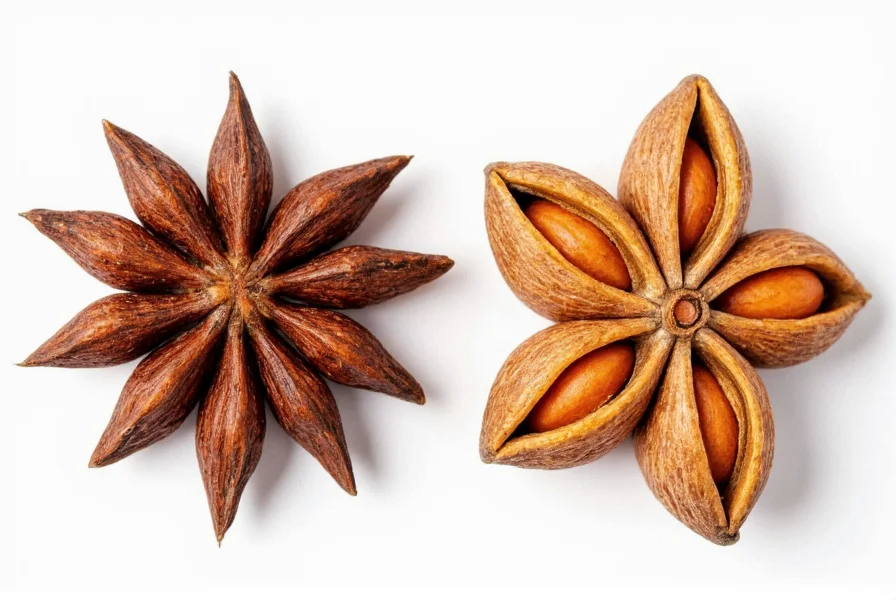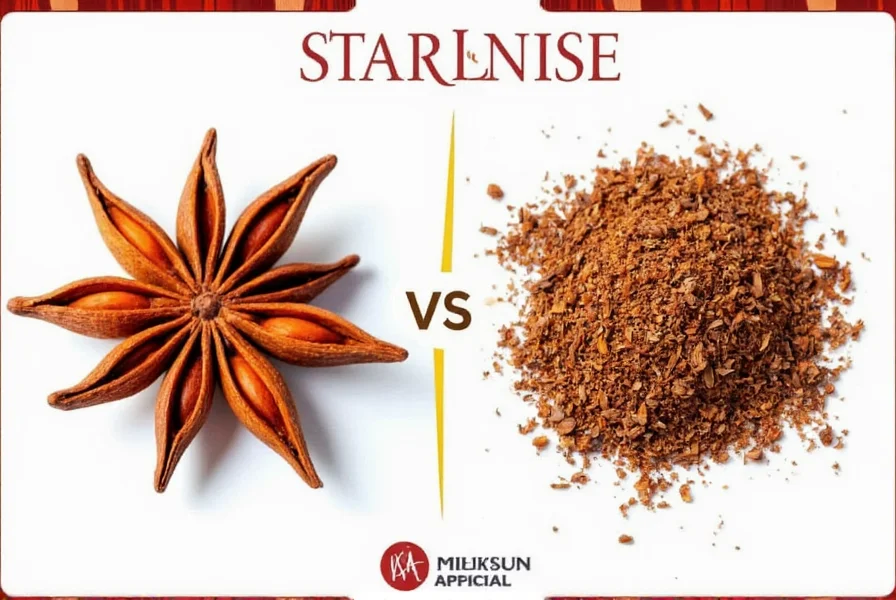When exploring the world of aromatic spices, few comparisons cause as much confusion as star anise vs anise. These two ingredients share a similar licorice-like flavor profile but originate from completely different plants with unique characteristics. This comprehensive guide clarifies the botanical distinctions, flavor profiles, culinary applications, and substitution guidelines to help home cooks and professional chefs use these spices effectively.
Botanical Origins and Physical Characteristics
Star anise comes from Illicium verum, an evergreen tree in the Schisandraceae family native to Southwest China and Vietnam. The spice consists of the star-shaped fruit pods, typically with 6-8 points, each containing a single seed. These reddish-brown pods measure approximately 1-2 inches across and maintain their distinctive shape when dried.
In contrast, anise (often called aniseed) derives from Pimpinella anisum, an annual herb in the Apiaceae family (related to parsley, carrots, and dill) originally cultivated in the eastern Mediterranean and Southwest Asia. Anise appears as small, grayish-brown crescent-shaped seeds about 1/8 inch long, with a single seed per fruit.
| Characteristic | Star Anise | Anise (Aniseed) |
|---|---|---|
| Botanical Name | Illicium verum | Pimpinella anisum |
| Plant Type | Evergreen tree | Annual herb |
| Part Used | Whole fruit pod | Seed |
| Appearance | Star-shaped pod (1-2 inches) | Small crescent seeds (1/8 inch) |
| Primary Growing Regions | China, Vietnam | Mediterranean, Middle East |
Flavor Profile Comparison
Both spices contain anethole, the compound responsible for their characteristic licorice flavor, but they express this flavor differently. Star anise delivers a more intense, slightly sweeter, and more complex flavor with subtle notes of citrus and spice. Its flavor remains stable during long cooking times, making it ideal for braises and stews.
Anise seed offers a more delicate, sweeter licorice flavor with subtle floral notes. The flavor is more volatile and diminishes with prolonged cooking, making it better suited for baked goods, beverages, and finishing dishes. When comparing star anise vs anise intensity, star anise is generally considered stronger and more pungent.
Culinary Applications
Star anise plays a crucial role in Asian cuisine, particularly in Chinese five-spice powder and Vietnamese pho broth. It's essential in Indian garam masala and frequently used in Middle Eastern and Persian dishes. Chefs typically add whole pods to simmering liquids for slow-cooked dishes, removing them before serving. The spice pairs exceptionally well with meats, especially pork and duck, and complements citrus flavors in desserts.
Anise seed features prominently in Mediterranean and European cooking. It's a key ingredient in Italian biscotti, Greek ouzo, Turkish raki, and French pastis. Bakers use ground anise in cookies, breads, and cakes. The seeds work well in fruit compotes, roasted vegetables, and fish dishes. When exploring star anise vs anise seed applications, note that anise works better in recipes requiring a more subtle licorice note.
Substitution Guidelines: Can You Swap Them?
While both spices share flavor similarities, they aren't perfect substitutes. Understanding when and how to substitute star anise for anise (or vice versa) prevents culinary disasters. For every 1 teaspoon of anise seed called for in a recipe, use 1 whole star anise pod. However, this substitution works best in liquid-based dishes where the star anise can be removed later.
When substituting anise for star anise, use 3/4 teaspoon of ground anise seed per star anise pod. This works better in baked goods than in long-simmering dishes. Remember that star anise vs anise substitution affects both flavor intensity and texture—star anise provides whole spice elements while anise seed is typically used ground.
Health Benefits and Safety Considerations
Both spices offer potential health benefits, though research remains preliminary. Star anise contains shikimic acid, a key ingredient in some antiviral medications, and shows antioxidant and anti-inflammatory properties in studies. Traditional medicine uses it for digestive issues and respiratory conditions.
Anise seed demonstrates potential benefits for digestion, menopausal symptoms, and as an expectorant. However, both spices contain compounds that may interact with certain medications. Crucially, avoid Japanese star anise (Illicium anisatum), which is toxic and sometimes mistakenly sold as Chinese star anise. Always purchase from reputable sources when exploring star anise vs anise for medicinal purposes.
Storage Recommendations
Proper storage preserves the volatile oils that give these spices their distinctive flavors. Store whole star anise pods in an airtight container away from light and heat—they maintain potency for 2-3 years. Ground star anise loses flavor more quickly, lasting only 6-12 months.
Anise seeds retain freshness for 1-2 years when stored in a cool, dark place in an airtight container. For maximum flavor, toast whole anise seeds briefly before grinding. Never store either spice near strong-smelling foods, as they readily absorb surrounding odors.
Common Misconceptions Clarified
Many people confuse star anise with anise due to their similar flavor profiles and names. However, they're not related botanically. Another common misconception is that anise and fennel are the same—they're not, though fennel seeds share some flavor similarities with anise.
When examining star anise vs anise seed differences, remember that star anise is significantly stronger, so direct substitution without adjustment usually results in overpowering flavors. Additionally, Chinese star anise (Illicium verum) is safe for consumption, while Japanese star anise (Illicium anisatum) is toxic—always verify your source.

Practical Usage Tips
For optimal flavor extraction, add whole star anise pods early in the cooking process for soups, stews, and braises. Remove pods before serving. In baking, grind star anise to incorporate evenly. When using star anise vs anise in beverages, steep whole pods for stronger flavor or use ground anise for more subtle notes.
For spice blends, toast whole star anise briefly before grinding to enhance flavor complexity. When making homemade extracts, star anise creates a more robust vanilla-almond flavor profile compared to anise's sweeter profile. Understanding these nuances helps maximize the unique qualities of each spice in your culinary creations.
What's the main difference between star anise and anise?
The primary difference is botanical origin: star anise comes from the fruit pods of an evergreen tree (Illicium verum), while anise refers to the seeds of an annual herb (Pimpinella anisum). Though both have licorice-like flavors due to anethole, star anise has a stronger, more complex flavor and distinctive star shape, while anise offers a sweeter, more delicate flavor in seed form.
Can I substitute star anise for anise in recipes?
Yes, but with adjustments. Use one whole star anise pod to replace 1 teaspoon of anise seeds in liquid-based dishes where the pod can be removed later. For dry recipes, substitute 1/2 teaspoon ground star anise for 1 teaspoon of anise seed. Remember that star anise has a stronger flavor, so you may need to reduce the quantity when substituting.
Which spice is stronger: star anise or anise?
Star anise is significantly stronger than anise seed. It has a more intense, complex licorice flavor with additional spicy and citrus notes. When comparing star anise vs anise intensity, you generally need less star anise to achieve a similar flavor impact. This intensity makes star anise better for long-cooking dishes, while anise works better where a more subtle flavor is desired.
Is Chinese star anise the same as regular anise?
No, Chinese star anise (Illicium verum) and regular anise (Pimpinella anisum) are completely different plants. Chinese star anise refers specifically to the star-shaped pods, while regular anise refers to the small seeds. Despite both containing anethole (which creates the licorice flavor), they come from unrelated plant families and have distinct flavor profiles, appearances, and culinary uses.
How should I store star anise and anise to maintain freshness?
Store both spices in airtight containers away from light, heat, and moisture. Whole star anise pods maintain potency for 2-3 years, while ground star anise lasts 6-12 months. Anise seeds stay fresh for 1-2 years when stored properly. For maximum flavor, toast whole anise seeds briefly before grinding. Neither spice should be stored near strong-smelling foods as they readily absorb surrounding odors.











 浙公网安备
33010002000092号
浙公网安备
33010002000092号 浙B2-20120091-4
浙B2-20120091-4